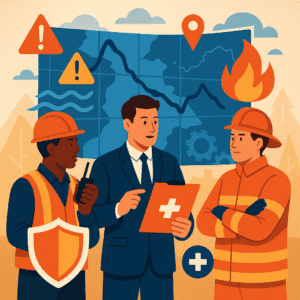What is Disaster Management? A Comprehensive Guide
In an era where the frequency and intensity of natural and human-induced calamities are on the rise, understanding the intricacies of what is disaster management is not just a matter of public policy, but a crucial aspect of community resilience and global stability. From devastating earthquakes and widespread floods to technological accidents and pandemics, the effective coordination of resources and responsibilities can mean the difference between chaos and recovery, life and death. This comprehensive guide delves into the core principles of disaster management, its critical phases, and the collaborative efforts required to build a safer, more resilient world.
The Core Concept: Defining Disaster Management
At its heart, disaster management is the organization and management of resources and responsibilities for dealing with all humanitarian aspects of emergencies,1 in particular preparedness, response, and recovery, in order to lessen the impact of disasters. It is a systematic approach that involves a multi-sectoral and proactive strategy to prevent, mitigate, prepare for, respond to, and recover from the adverse impacts of hazards.
The ultimate goal of disaster management is to build a resilient society that can withstand the shocks of disasters and bounce back stronger. This involves a continuous and integrated process of planning, organizing, coordinating, and implementing measures that are necessary for2 the prevention of danger or threat of any disaster, mitigation or reduction of risk of any disaster or its severity or consequences, capacity-building, preparedness to deal with any disaster, prompt response to any threatening disaster situation or disaster, assessing the severity3 or magnitude of effects of any disaster, evacuation, rescue, and relief, and rehabilitation and reconstruction.4
The Disaster Management Cycle: A Framework for Action
Effective disaster management is not a one-time event but a continuous cycle of activities. This cycle is traditionally divided into four key phases, each with its own set of objectives and activities. While presented as a sequence, these phases often overlap and are interconnected.
Phase 1: Mitigation
Mitigation refers to actions taken to prevent or reduce the risk of disasters. This is a proactive phase that aims to minimize the loss of life and property by addressing the root causes of vulnerability. Key mitigation strategies include:
- Structural Measures: These involve the construction of disaster-resistant infrastructure, such as earthquake-proof buildings, flood levees, and cyclone shelters. Adherence to building codes and land-use planning are crucial components of structural mitigation.
- Non-Structural Measures: These focus on policies, public awareness, and education to reduce risk. Examples include creating hazard maps, implementing early warning systems, and promoting public education campaigns on disaster risk. High-authority sources like the Federal Emergency Management Agency (FEMA) in the United States provide extensive resources on mitigation planning.
Phase 2: Preparedness
While mitigation aims to reduce the likelihood and impact of disasters, preparedness focuses on building the capacity to respond effectively when a disaster does occur. This phase involves planning, training, and equipping individuals, communities, and organizations to handle emergencies. Key preparedness activities include:
- Developing Emergency Plans: This involves creating detailed plans for evacuation, communication, and resource allocation.
- Training and Drills: Regular drills and exercises help to test the effectiveness of emergency plans and ensure that responders and the public know what to do in a crisis.
- Stockpiling Supplies: This includes gathering essential supplies such as food, water, medical supplies, and emergency equipment.
- Establishing Early Warning Systems: Effective warning systems are critical for alerting the public to impending threats, allowing them to take protective action.
Phase 3: Response
The response phase begins immediately after a disaster strikes. The primary goal of this phase is to save lives, provide immediate assistance to victims, and prevent further damage. Key response activities include:
- Search and Rescue: Locating and rescuing individuals who are trapped or injured.
- Emergency Medical Services: Providing first aid and medical care to the injured.
- Shelter and Relief: Establishing temporary shelters and distributing essential supplies like food, water, and blankets to those affected.
- Damage Assessment: Conducting initial assessments to understand the extent of the damage and prioritize response efforts.
International organizations like the United Nations Office for the Coordination of Humanitarian Affairs (OCHA) play a pivotal role in coordinating international response efforts during major disasters.
Phase 4: Recovery
The recovery phase begins once the immediate threat to human life has subsided. This is a long-term process aimed at restoring and improving the community’s physical, social, economic, and environmental well-being. The recovery phase is often broken down into two sub-phases:
- Short-Term Recovery: This involves restoring essential services such as power, water, and communication, as well as clearing debris and providing temporary housing.
- Long-Term Recovery: This focuses on rebuilding infrastructure, rehabilitating livelihoods, and implementing measures to reduce future vulnerability. This phase presents an opportunity to “build back better” by incorporating mitigation measures into the reconstruction process. The World Bank’s Global Facility for Disaster Reduction and Recovery (GFDRR) actively supports countries in their long-term recovery efforts.
Types of Disasters: Natural and Human-Induced
Disasters can be broadly categorized into two main types: natural and human-induced.
Natural Disasters
These are adverse events that result from natural processes of the Earth. Examples include:
- Geophysical Disasters: Earthquakes, volcanic eruptions, tsunamis, and landslides.
- Hydrological Disasters: Floods and avalanches.
- Climatological Disasters: Extreme temperatures, drought, and wildfires.
- Meteorological Disasters: Cyclones and storms.
- Biological Disasters: Epidemics and insect infestations.
Human-Induced Disasters
These are disasters that are caused by human actions or inactions. They can be intentional or unintentional. Examples include:
- Technological Disasters: Industrial accidents, oil spills, and nuclear meltdowns.
- Transportation Accidents: Plane crashes, train derailments, and major road accidents.
- Complex Emergencies: Conflicts, civil strife, and famines that are often exacerbated by political and social factors.
The Importance of Disaster Management in the Modern World
The increasing frequency and complexity of disasters underscore the critical importance of effective disaster management. Here are some of the key reasons why disaster management is essential:
- Saving Lives and Reducing Suffering: The primary objective of disaster management is to protect human lives and reduce the suffering of affected populations.
- Minimizing Economic Losses: Disasters can have a devastating impact on economies. Effective mitigation and preparedness can significantly reduce the financial costs of disasters.
- Protecting the Environment: Disasters can cause severe environmental damage. Disaster management strategies aim to minimize this damage and promote sustainable recovery.
- Ensuring Social and Political Stability: Large-scale disasters can lead to social unrest and political instability. A well-coordinated disaster management system can help to maintain order and provide a sense of security to the public.
- Building Resilient Communities: By empowering communities with knowledge and resources, disaster management helps to build resilience, enabling them to better withstand and recover from future shocks.
The Role of Technology in Revolutionizing Disaster Management
Technological advancements have significantly enhanced our ability to manage disasters. Key technologies that are transforming the field include:
- Geographic Information Systems (GIS) and Remote Sensing: These technologies are used for hazard mapping, risk assessment, and damage assessment.
- Early Warning Systems: Sophisticated sensor networks, satellite imagery, and communication technologies enable the rapid dissemination of warnings.
- Drones and Unmanned Aerial Vehicles (UAVs): Drones are used for search and rescue operations, damage assessment, and delivering emergency supplies.
- Artificial Intelligence (AI) and Big Data: AI and big data analytics are used to predict disaster patterns, optimize response efforts, and analyze social media for real-time situational awareness.
- Mobile Technology: Mobile phones are powerful tools for communication, disseminating warnings, and collecting data from affected populations.
International Cooperation and Frameworks
Disasters often transcend national borders, necessitating international cooperation. Several international frameworks guide global efforts in disaster risk reduction. The most prominent of these is the Sendai Framework for Disaster Risk Reduction 2015-2030, adopted by UN member states in 2015. This framework outlines seven global5 targets and four priorities for action to prevent new and reduce existing disaster risks. You can learn more about this framework on the United Nations Office for Disaster Risk Reduction (UNDRR) website.
Challenges and the Future of Disaster Management
Despite significant progress, the field of disaster management faces numerous challenges, including:
- Climate Change: A changing climate is leading to more frequent and intense extreme weather events.
- Rapid Urbanization: Unplanned urbanization is increasing the vulnerability of populations in many parts of the world.
- Inequality and Vulnerability: Disasters disproportionately affect the poorest and most marginalized populations.
- Funding Gaps: There is often a significant gap between the funding required for disaster risk reduction and the resources that are available.
The future of disaster management lies in a more integrated, inclusive, and proactive approach. This will require greater investment in mitigation and preparedness, a stronger focus on community-based disaster risk management, and the innovative use of technology.
Conclusion: A Shared Responsibility
In conclusion, what is disaster management is a multifaceted and dynamic field that is essential for safeguarding lives, livelihoods, and the environment in an increasingly hazardous world. It is not solely the responsibility of governments and international organizations. Every individual, community, and organization has a role to play in building a culture of prevention and resilience. By understanding the principles of disaster management and taking proactive steps to reduce risk, we can collectively work towards a safer and more sustainable future for all.




